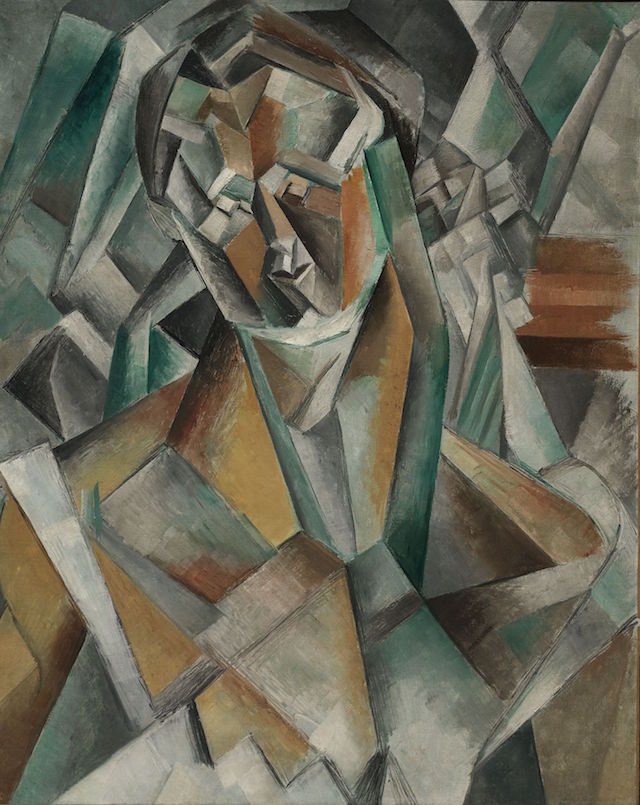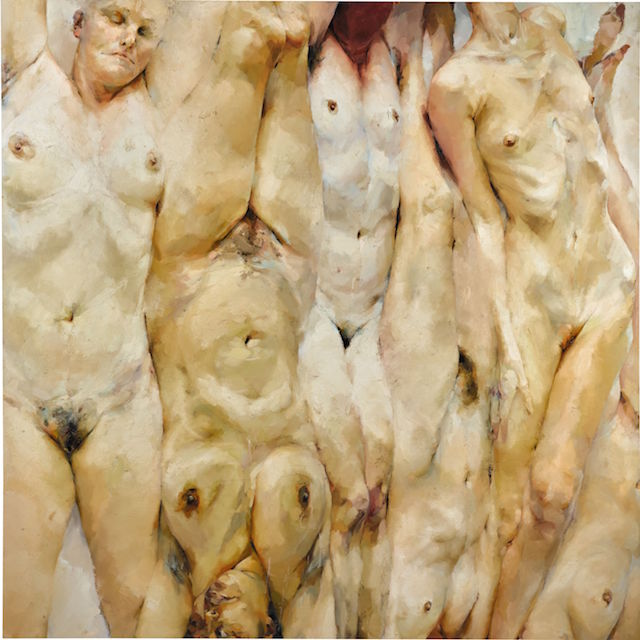Exceptional French and British works of art ornamented the June auctions in Paris and London – extravagant icing on what were, if honest, rather thin cakes. This frosting of museum-quality offerings began in Paris with the sale of a designated National Treasure at Artcurial on 6 June. This was an early Marcel Duchamp painting, Nu sur nu of 1910–11, executed just months before his celebrated cubist/Futurist game-changer, Nu descendant l’escalier, n°2 – Duchamp before Duchamp, as it were.
At this time the artist was seeking a new means of expression, and here we see him attracted to the Symbolism of Odilon Redon. The standing woman appears to have emerged fully grown, her hair a halo of green, from the monumental body of the woman behind. The canvas had belonged to Duchamp’s friend, the art publisher Arnold Fawcus of the Trianon Press, whose heirs donated it to Médecins Sans Frontières. Artcurial had put an estimate of €500,000–€700,000 on this much-exhibited curiosity. Four serious bidders were in pursuit and it sold for €1.2m to an international collector, despite the fact that it cannot leave France.
Nu sur nu (1910–11), Marcel Duchamp. © Artcurial

The following week, the Musée du Louvre pre-empted the sale of the last two hooded mourners to remain in private hands, originally carved for the tomb of the duc de Berry, the great 14th-century patron. Jean de Cambrai carved the life-size recumbent figure of the royal duke and five of the 40 alabaster mourners who stood in the architectural niches beneath, including these two. Some 29 are known to have survived the monument’s despoliation during the Revolution. Two, not carved by the master’s hand, fetched just over €4m in 2013; these, consigned from the same collection, fetched €5m.
Another museum-worthy French masterwork was offered in London on 21 June, as sculptural as any two-dimensional painting could be. This was Picasso’s Femme Assise, part of a seminal series of images of his model and companion Fernande Olivier made in 1909. Here, the artist was formulating a radical new formal language based on shifting viewpoints and rendering form – whether of two or three dimensions – in terms of faceted planes. No one could deny the art-historical importance of this early cubist work – the question was whether any sufficiently rich collector would be interested in anything so cerebral. Two were, and they slowly pushed the price up to £43.3m.
Femme assise (1909), Pablo Picasso. Courtesy Sotheby’s

This was a successful sale, not least because Modigliani’s portrait Jeanne Hébuterne (au foulard) also soared over estimate – seemingly everything by this artist does at the moment – selling for £38.5m. An impressive 92 per cent of the auction sold by value and 89 per cent by lot (the major casualty was the late, life-size cast of Rodin’s bronze Éve [estimate £8m–£12m], which failed to find a buyer), but its slim offering of just 27 lots may be read as a sign of these challenging times – as was the fact that a work of art, Joaquín Torres-García’s Peinture constructive of 1931, could make it into the Top 10 at an Impressionist & Modern Art evening sale with a price of under £1m.
By contrast, Christie’s London’s sale looked weak, but that again was due to the lack of estate sales – the backbone of this market at auction – and also because its strongest lots had been pulled out to fuel the firm’s 250th-anniversary auction, Defining British Art, on 30 June. This cross-category cracker of a sale totalled £99.5m and set new auction records for eight artists. Even here, however, there was no great depth of bidding, and few lots were pushed beyond their upper estimate. Those that were included Frank Auerbach’s encrusted monochrome Head of Leon Kossoff of 1954, which fetched a record £2.7m, and a 1966 Bridget Riley, Untitled (Diagonal Curve). Both appear to have gone to Asian collectors. Riley’s mesmerising canvas of undulating, evenly spaced back and white lines agitate the eye into dynamic pulsating rhythms. One of the last Op Art experiments the artist made before she turned to colour, it changed hands for a record £4.3m.
As ever, there were surprises: a single bidder for Lord Leighton’s glorious Golden Hours (secured for a record £3.3m), and no bids at all for Freud’s Ib and her Husband of 1992 – ‘Well, did you think it was sexy?’ someone challenged me after the sale. Perhaps most unexpected was the £1.4m paid for the small but dazzling Picardy seascape by Richard Parkes Bonington (estimate £400,000–£600,000). While Constable’s museum-worthy, full-scale oil sketch View on the Stour near Dedham was not acquired by an institution at just over £14m, the auctioneer quipped that it might end up in one.
The sale’s top lot, however, was the monumental Henry Moore bronze Reclining Figure: Festival, which soared beyond expectations to change hands for £24.7m, an auction record for the artist. Conceived in 1951, this was Moore’s most radical interpretation of the female form to date, an open, rhythmic arrangement of undulating forms enhanced by bronze string lines and a beautifully preserved surface. Bonhams also found a new record for a Moore plaster. Reclining Nude of 1945 flew beyond its estimate of £150,000–£200,000 to sell for £1.8m. It was the top offering of modern British art from the Reddihough collection, all of which sold on 15 June. Barbara Hepworth’s drawing Seated Girl, for instance, changed hands for £206,500, against an estimate of £30,000–£40,000.
Another stellar price for a British work was found at Sotheby’s Contemporary Art evening sale on 28 June. Here Jenny Saville’s Shift more than tripled expectations to sell to the acquisitive Long Museum in Shanghai for a record £6.8m. This over three-metre ‘body pile’ or curtain of lusciously painted female flesh was exhibited in the infamous ‘Sensation’ exhibition at the Royal Academy in 1997. This strong sale also saw a record £4.2m paid for Keith Haring’s last great work, The Last Rainforest, of 1989.
Shift (1996–97), Jenny Saville. Courtesy Sotheby’s

Economic uncertainty surrounding the EU referendum had, according to the auction houses, made consignments harder to obtain this season. It also prompted further guarantees in some cases, and discouraged some collectors from competing. The drop in the value of sterling, however, made purchases more appealing to international buyers, and Christie’s noted strong buying from the Americas. As for the longer view, Christie’s sales figures for the first half of 2016 (£2.1bn) were 29 per cent down on last year, mainly due to a drop in the supply of works of art valued over £20m. Interestingly, new clients accounted for a quarter of all buyers in these sales. Sotheby’s figures were unavailable at the time of writing.
From the September issue of Apollo: preview and subscribe here.



